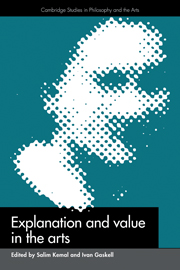Book contents
- Frontmatter
- Contents
- List of contributors
- Editors' acknowledgments
- 1 Interests, values, and explanations
- 2 Fiction and reality in painting
- 3 Franz Kafka: the necessity for a philosophical interpretation of his work
- 4 On relocating ethical criticism
- 5 Explanation and value: what makes the visual arts so different, so appealing?
- 6 Is art history?
- 7 Objectivity and valuation in contemporary art history
- 8 Fullness and parsimony: notes on creativity in the arts
- 9 Principles of a sociology of cultural works
- 10 Althusser and ideological criticism of the arts
- 11 Film, rhetoric, and ideology
- Index
10 - Althusser and ideological criticism of the arts
Published online by Cambridge University Press: 24 February 2010
- Frontmatter
- Contents
- List of contributors
- Editors' acknowledgments
- 1 Interests, values, and explanations
- 2 Fiction and reality in painting
- 3 Franz Kafka: the necessity for a philosophical interpretation of his work
- 4 On relocating ethical criticism
- 5 Explanation and value: what makes the visual arts so different, so appealing?
- 6 Is art history?
- 7 Objectivity and valuation in contemporary art history
- 8 Fullness and parsimony: notes on creativity in the arts
- 9 Principles of a sociology of cultural works
- 10 Althusser and ideological criticism of the arts
- 11 Film, rhetoric, and ideology
- Index
Summary
Louis Althusser's 1970 essay “Ideology and ideological state apparatuses” is arguably the most influential and important document in contemporary critical practice and its theory. In one way this is puzzling, for the essay contains almost nothing that can be recognized as an argument. It does not put forward a causal theory of the rise and fall of forms of social life. It offers no deductions, and it contains only a few sketchily described examples of ideologies. The essay is instead filled with oracular pronouncements, couched in a terminology partly invented and partly cobbled together from the Marxist tradition and from Lacan.
Yet there it is. Althusser's work receives more extended discussion – thirty-five consecutive pages, plus numerous occasional references – in Fredric Jameson's 1981 The Political Unconscious, perhaps the most important American text in so-called New Historicist criticism, than any of the literary works Jameson considers except Conrad's Lord Jim. Althusser is the principal subject of the longest chapter in Rosalind Coward and John Ellis's 1977 Language and Materialism, itself one of the principal theoretical works of so-called cultural materialist criticism in England, and the discussion of “Ideology and ideological state apparatuses” is the centerpiece of that chapter. Terry Eagleton observes that in this essay “Althusser has taught us to regard…[the] misperceptions [of] the infantile narcissist of the Lacanian mirror stage…as an indispensable structure of all ideology,” where ideology is omnipresent. By allusion the essay appears in hundreds of titles such as The Ideology of the Aesthetic, The Romantic Ideology, Aesthetics and the Ideology of Form, Ideology and Imagination in the Victorian Novel, and so on.
- Type
- Chapter
- Information
- Explanation and Value in the Arts , pp. 190 - 214Publisher: Cambridge University PressPrint publication year: 1993
- 1
- Cited by



